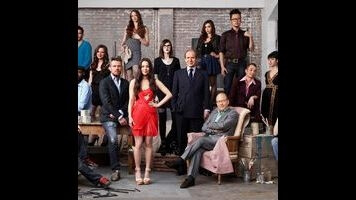Work Of Art: The Next Great Artist: “The Big Show”

One of the reasons I signed up to recap Work Of Art is that I like shows about the creative process. That’s why I’ve always enjoyed Project Runway, and I thought I’d be getting something similar with this show. But Work Of Art never did a terribly good job of investigating process—despite all the footage from the artists' studio, I often had only a vague idea of how the artists had developed their works in the act of crafting them. It’s the show’s biggest shortcoming, and I hope they address it for the second season (which appears to be happening, judging by the casting calls throughout tonight’s airing).
It wasn’t a fatal flaw, though. Instead of process, Work Of Art focused more on concept—specifically, inspiration and presentation, the things that happen on either end of physically creating a work. In these respects, the show did a pretty good job, better than I expected for a basic-cable TV show. Most episodes gave me a grasp of what was driving the artists—how they arrived at their ideas—which was a valuable insight in evaluating they work they ultimately produced. At first, this inside knowledge felt kind of like cheating, because there was no way to assess the works “on their own,” but of course there’s no such thing as “on their own.” There’s always a context, and the reality TV format provided an interesting one.
Tonight’s season finale was heavy on context, as Simon took on the standard finale ritual of visiting each artist’s home for a check-in. First on the itinerary was Peregrine, who greeted Simon in her huge wonderland of a working space, surrounded by Seussian brass instruments. She introduced her husband. “You are a jazz musician?” Simon asked. “Jazz musician and horn sculptor,” Mr. Peregrine said, because hell yes, if you have “horn sculptor” on your business card, you’d better own that shit. Then Peregrine strapped on an elaborate two-person horn for her husband to play. It sounded very cool, and I would have liked to spend more time with the horn guy, but there was also this art show to do. So we moved on.
Abdi and Miles’ visits were quick and standard. Abdi’s mom loves him; so do Miles’ parents. Revelations from their past: They both have been just super-duper at art for a while now. In the mentoring sessions, Simon was troubled by an over-technical quality in Abdi’s work, and he was encouraged by Miles’ ideas, although not to the bubbly extent we’ve often seen from The World’s Most Enthusiastic Swiss Man.
In New York, the artists prepared their exhibitions in Simon’s auction house. Miles and Peregrine had no problems, while Abdi once again struggled with a hastily completed sculptural piece—various limbs and appendages were cracking away from his fallen basketball heroes as he chiseled away excess plaster. What is it with this guy? Did Abdi have any trouble-free sculptures in his Work Of Art run? (Maybe the TV-head one?)
The showtime was a big, happy reunion. Former guest judges Andres Serrano and Richard Phillips noted how much more awesome the artists seemed now, in comparison to the early-season bunch of sucks they had to deal with. Nao offered some sharp observations from within her outfit/cocoon, an explosion of fabric and bird netting, making us rue the day she got kicked off in a gimmicky double elimination. Executive producer Sarah Jessica Parker assessed the artists and marveled, “It’s great and exciting to see that they DO have futures!” Indeed, they may now continue to exist, thanks to their patron SJP, a modern-day Medici.
Then it was time to judge a winner, because this was also a game show, being played for no small prize, either. The surprise was that Miles lost, although once the gallery show was underway, it was clear that the judges couldn’t justifiably award Miles the win. His work was too procedural in any setting, and especially in a show like this one that doesn’t value process.
I felt that Miles was in trouble as soon as I heard his source of inspiration—he had been taking photos of surveillance videos at a local White Castle, and he learned that one of his subjects, a homeless man, had frozen to death days after Miles took his picture. It could have been the basis of something profound. Here was this discarded person, and the only known record of him was Miles’ cameraphone recording of a fuzzy surveillance feed. What a ludicrous, paltry imprint to leave behind. Was there any humanity to be found in that inadequate digital file?
Maybe, but Miles didn’t find it. He didn’t even look. This work depended on Miles’ ability to tell a story with his pieces, which has never been his strength—he’s succeeded by creating beautiful, logical structures for the viewer to engage with. The ultra-zoomed-in pixel art was boring; he willfully squandered his inspiration, and what remained was idiosyncratic squares. In the Q&A with judges, he retold the story of the homeless man, knowing what a great TV moment it would make, but he could not connect the dots from that sad moment to his emotionless piece. A huge disappointment.








































